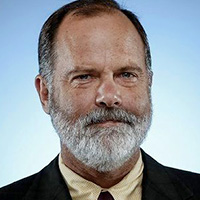THIS MARKS THE FIRST OF TWO CONNECTED ISSUES OF BLUEPRINT, both devoted to the existential challenge of this generation: how to reorient society so that humanity no longer uses more than the Earth produces and so that temperatures may level off or someday decline. In this issue, we confront that challenge in the area of electricity — from power plants to cars. In our next, we will turn to a dimension of particular interest to California: water.
Climate change is often addressed as a technological challenge, and it is that. More efficient batteries are allowing electric cars to improve range and may offer ways to balance out electricity usage; refinements of wind and solar energy are allowing vast growth in the capacity of those systems to generate power. At UCLA, Professor Rajit Gadh, with support from the U.S. Department of Energy, leads an ambitious effort to reimagine the modern electrical grid, including its interaction with electric vehicles. His work and some of the other pioneering projects around California are featured in this issue’s information-rich map.
But there are political and behavioral dimensions to this challenge as well. What policies will best encourage consumers to save energy or to invest in renewables? How might tax incentives broaden the appeal of electric vehicles without simply making it a little easier for millionaires to buy Teslas? How can policymakers press for greater heating and cooling efficiency in buildings — from shopping malls to private homes — without first understanding where power is being used well and where it’s being wasted?
Those are the questions that underscore much of the research featured in this issue of Blueprint — issues not so much about the science of climate change as about the ability of humans to respond and the effectiveness of government in trying to encourage that response.
In addition, we offer close looks at two of the most important public officials in this field, whose work individually and together has produced groundbreaking progress in California. Gov. Jerry Brown and Mary Nichols, who chairs the California Air Resources Board, have been at the forefront of environmental protection, especially in the field of air pollution, since Brown first appointed Nichols to that board in 1975. Theirs is an overlapping story of two visionary and controversial figures.
They were fighting pollution back when it was seen as avant garde, even kooky, to tout such ideas as solar energy. Gov. Brown reflects on those years — when he was sometimes teased as “Governor Moonbeam” — in this issue’s Table Talk. And Nichols, who was named one of the 100 Most Influential People in the World by Time magazine in 2013 (Brown made it the following year), is the subject of our latest Profile.
The nature and complexity of climate change has generated an explosion of research, and we recognize that we’ve only begun to scratch the surface with the articles here. UCLA’s Grand Challenge, for one, is attempting to marshal resources from around the campus in order to help Los Angeles become energy and water self-sufficient in the coming decades, and im- portant work is being done around the world in these and related fields. We’ll take another bite at these problems with Part 2; for now, however, we’re happy to present some of the cutting-edge work being done on one of the gravest challenges facing the modern world.
Thank you for your interest in Blueprint and the issues we’re covering.























